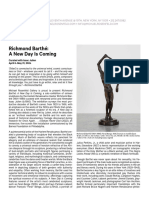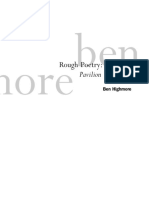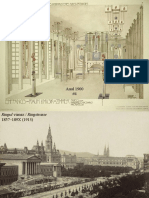Survey Article On The Turner Prize Shortlist
Survey Article On The Turner Prize Shortlist
Uploaded by
Pádraig BeltonCopyright:
Available Formats
Survey Article On The Turner Prize Shortlist
Survey Article On The Turner Prize Shortlist
Uploaded by
Pádraig BeltonOriginal Title
Copyright
Available Formats
Share this document
Did you find this document useful?
Is this content inappropriate?
Copyright:
Available Formats
Survey Article On The Turner Prize Shortlist
Survey Article On The Turner Prize Shortlist
Uploaded by
Pádraig BeltonCopyright:
Available Formats
A R T S & C U LT U R E
The Turner Prize Shortlist
The Turner Prize Shortlist
BY PDRaiG BElton
this page: Crane by Hilary lloyd opposite page: no Reflections by martin Boyce
42
Oasis Magazine
one has to feel sorry for tabloids, inhabiting a parallel universe lacking a turner Prize. the sun would be bereft of the headline, inspired by Karla Blacks polythene art, how to bag a turner prize. the Daily mail plumps for the more elegantly polysyllabic, suspended ball of plastic is favourite to win prize. it is where the clowns of the art world annually descend. (note for libel lawyers: this is not a term of abuse. the anti-turner Prize stuckists, interesting sorts like Charles thomson, annually rock up to picket, clad in variations on Watteaus Pierrot.) this year it is a short-list of fourtwo painters, two sculptorsdescending without precedent from london to the provinces, to tyne and Wear and the nine-year old Baltic Centre for Contemporary art, in Englands obscure colony called the north. next year they go to Belfast, and a different north (and colony). one almost sniffs a theme: half this years short-list, and the preceding two years victors, derive from Glasgow (which is northern to excess). not only the turner, but British art itself is on a journey away from london, and the Young British artists familiar territory of Goldsmith and warehouses converted to galleries in the East End. Glaswegian is the new shoreditch. significantly, none of this years short-list ventured for university to london. selected on the 5th of may, they shall joust until the 5th of December, in exhibition at the Baltic centre from the 21st of october. For such a solid fixture of the British artistic and journalistic calendar, its all quite new: the turner only dates to 1984, missing a beat in 1990 due to a bankrupt sponsor, but along the way contriving to launch Damien Hirst, Gilbert & [sic] George, anish Kapoor and antony Gormley to public view. its controversial, most visible feature, the shortlist, was dropped in 1986; which turned out more controversial still, and it has since grown to part of the institution, and the fun it provides. the contestants, then. Karla Blacks sculpture is one of tactile, domestic materials, forged for particular site through some form of physical struggle, and then afterward destroyed. nail varnish, Vaseline and body lotion all figure in her studio in industrial quantities, resulting in an artistry of psychological vulnerability: it has been described as if she began making herself up for a saturday night, but found herself painting instead. Her fellow Glaswegian sculptor Martin Boyce is the previously best-known of this quartet: he represented scotland in the 2009 Venice Biennale, with a melancholic dreamscape of upturned dustbins, rusty tables and castaway benches; as if one landscape had blown through another, like the convergence of ancient Venice with the comments and emendations deposited by modernist architect Carlo scarpa. the tate own four of his works. Brooding, masculine, they often quote the modernist design history from which they emerge: but with an elegiac quality, reflecting on the unrealised opportunities
and intentions of jol and jan martels concrete cubist trees in Pariss 1925 Exposition des arts Dcoratifs. an observer mused Boyces version were playground climbing frames designed to poke a childs eye out. to these two sculptors, there is a complementing pair devoted to the image. the autobiographical urban landscapist George Shaw, recasting the tile Hill council estate of his youth in the sheen of Humbrol enamel, might well prove the first naturalist painter to figure on a turner shortlist. Humbrol being the paint of model kits and youth, the sheen is a twofold gloss: the glow you see only on nocturnal walks home unaccompanied, a repository of hinted personal imports, and a gesture away from the strictly representational to suggest both remembrance and the overlooked or mysterious at play in the quotidian. the hinted thrill of peril, fundamentally adolescent, crumbles in adult gaze supplying darker undertones. Hilary Lloyd, in her installations, relishes the foregrounding of kit: projectors and monitors which seem to form part of the work itself, suggesting variant modes of seeing. quieting and fragmenting the corporeal form with which her work repeatedly begins, the mechanical often for her becomes, fetishised and appreciated for its sculptural qualities, a simulacrum for human identity. a different direction wholly was her studio #2 (2009), displayed at the Frieze art Fair in 2009, wherein four video projections each displayed a meticulously wrought study of reflected light, suggesting the op-art of Vasarly, or a hallucinogenic. the immediacy achieved by shaw and Black suggests they may gain a march on the more abstracted work of the other two. But who knows? second-guessing the turner Prize judges is a rite of spring, a comfortable calendar perennial. and one wondered when the turner was going to grow up and leave home.
You might also like
- Bharat Tex 2024 Planner SampleDocument4 pagesBharat Tex 2024 Planner Samplearnoldwilliam059No ratings yet
- Baudelaire - Mirror of Art (Recovered)Document468 pagesBaudelaire - Mirror of Art (Recovered)Galen Gillam100% (1)
- Enjoying Modern Art (Art Ebook)Document274 pagesEnjoying Modern Art (Art Ebook)Prim100% (6)
- Hoffmann Jens - Other Primary Structures IntroDocument4 pagesHoffmann Jens - Other Primary Structures IntroVal RavagliaNo ratings yet
- All The Paintings of Caravaggio (Art Ebook)Document150 pagesAll The Paintings of Caravaggio (Art Ebook)Orquid Hands100% (7)
- Paul Poiret: King of Fashion (1879 - 1944)Document16 pagesPaul Poiret: King of Fashion (1879 - 1944)Rita Marques100% (1)
- Syllabus HIAA 0850 Modern Architecture 2017Document6 pagesSyllabus HIAA 0850 Modern Architecture 2017emmagould48No ratings yet
- Extract: Romantic Moderns by Alexandra HarrisDocument13 pagesExtract: Romantic Moderns by Alexandra HarrisThe GuardianNo ratings yet
- 2024-0406 Richmond Barthé Digital PRDocument2 pages2024-0406 Richmond Barthé Digital PRmustaphalamtaouiNo ratings yet
- 1992 05 HelterSkelter reviewonPrintCollectorsDocument3 pages1992 05 HelterSkelter reviewonPrintCollectorsluis_rhNo ratings yet
- A Quarterly Review of Contemporary "Abstract" Painting& Sculpture Editor: Myfanwy EvansDocument37 pagesA Quarterly Review of Contemporary "Abstract" Painting& Sculpture Editor: Myfanwy EvansAliciaNo ratings yet
- Corot To Monet French Landscape PaintingDocument2 pagesCorot To Monet French Landscape PaintingDeltai KárolyNo ratings yet
- British Highlights - MergedDocument11 pagesBritish Highlights - MergedGavelNo ratings yet
- 02 - Intervencija Crtezom U Interijeru - Walter de MariaDocument5 pages02 - Intervencija Crtezom U Interijeru - Walter de MariaKristijan VrdoljakNo ratings yet
- (Art Journal Vol. 60 Iss. 4) Review by - Theresa Leininger-Miller - Continuing The Vogue For Paris Noir (2001) (10.2307 - 778201) - Libgen - LiDocument4 pages(Art Journal Vol. 60 Iss. 4) Review by - Theresa Leininger-Miller - Continuing The Vogue For Paris Noir (2001) (10.2307 - 778201) - Libgen - Liada karakuşNo ratings yet
- Folland - Readymade Primitivism: Duchamp, Dada and African - ArtDocument26 pagesFolland - Readymade Primitivism: Duchamp, Dada and African - ArtKarine Raynor100% (1)
- When Attitudes Become Form Barry BarkerDocument3 pagesWhen Attitudes Become Form Barry BarkerEmilia CasivaNo ratings yet
- Art November 2012Document47 pagesArt November 2012ArtdataNo ratings yet
- Roger Scruton Art KistchDocument10 pagesRoger Scruton Art KistchGabriel ParejoNo ratings yet
- 41415633Document4 pages41415633SigilarusNo ratings yet
- Stokes, Adrian - The Image in Form PDFDocument340 pagesStokes, Adrian - The Image in Form PDFguglielmobilancioni50% (2)
- The Portrait NowDocument132 pagesThe Portrait NowMaman SajaNo ratings yet
- Postmodern Criticism and ArtDocument45 pagesPostmodern Criticism and ArtRangothri Sreenivasa Subramanyam0% (1)
- QCA Study Tour - Gabrielle MactaggartDocument39 pagesQCA Study Tour - Gabrielle MactaggartQCA GriffithNo ratings yet
- Pop in The AgeDocument15 pagesPop in The AgeAngelica GonzalezNo ratings yet
- Pictures Every Child Should Know: A Selection of the World's Art Masterpieces for Young PeopleFrom EverandPictures Every Child Should Know: A Selection of the World's Art Masterpieces for Young PeopleNo ratings yet
- The Ten Essential Artworks at MoMA 1Document12 pagesThe Ten Essential Artworks at MoMA 1Carlos Vicente Losa RevueltaNo ratings yet
- 38 Rough Poetry Patio and Pavilion RevisiteDocument22 pages38 Rough Poetry Patio and Pavilion RevisiteRafael GonçalvesNo ratings yet
- James McNeill WhistlerDocument9 pagesJames McNeill WhistlerDavid BriceñoNo ratings yet
- The Art of Looking How To Read Modern and Contemporary Art (Esplund, Lance) (Z-Library)Document240 pagesThe Art of Looking How To Read Modern and Contemporary Art (Esplund, Lance) (Z-Library)madhu smriti100% (1)
- 2011 Oct CTP Eve Sale PR 22.9.11Document5 pages2011 Oct CTP Eve Sale PR 22.9.11GavelNo ratings yet
- Aesthetic Literature Fine Art Decorative Arts Symbolism Decadence Decadentismo Modernism Victorian Period Oscar WildeDocument16 pagesAesthetic Literature Fine Art Decorative Arts Symbolism Decadence Decadentismo Modernism Victorian Period Oscar WildecristiscemoNo ratings yet
- Dec. 4, 2020 Antiques & The Arts Weekly Charlestown BookDocument5 pagesDec. 4, 2020 Antiques & The Arts Weekly Charlestown BookJustin W. ThomasNo ratings yet
- The Art of Acquiring: A Portrait of Etta & Claribel ConeFrom EverandThe Art of Acquiring: A Portrait of Etta & Claribel ConeRating: 3.5 out of 5 stars3.5/5 (2)
- Mystical Symbolism: The Salon de La Rose+Croix in Paris, 1892-1897Document23 pagesMystical Symbolism: The Salon de La Rose+Croix in Paris, 1892-1897naciNo ratings yet
- Karin LambrechtDocument93 pagesKarin LambrechtLilian ShimohiraoNo ratings yet
- Turner MOMADocument73 pagesTurner MOMAblascocubas_maNo ratings yet
- Pop Surrealism Magazine - Summer 2011Document43 pagesPop Surrealism Magazine - Summer 2011PopSurrealism100% (3)
- KCT 023Document3 pagesKCT 023唐亦鑫No ratings yet
- In Montparnasse: The Emergence of Surrealism in Paris, from Duchamp to DalíFrom EverandIn Montparnasse: The Emergence of Surrealism in Paris, from Duchamp to DalíRating: 4.5 out of 5 stars4.5/5 (7)
- Death and Disney: The Venice BiennaleDocument4 pagesDeath and Disney: The Venice BiennaleAngelica GonzalezNo ratings yet
- Pierre Bonnard: The Graphic ArtDocument274 pagesPierre Bonnard: The Graphic ArtGizem Sozen92% (13)
- Kitsch and The Modern PredicamentDocument9 pagesKitsch and The Modern PredicamentDaniel Mutis SchönewolfNo ratings yet
- Les Mardis de Stephane MallarmeDocument75 pagesLes Mardis de Stephane Mallarmeclausbaro2No ratings yet
- Meyer Schapiro - Courbet and Popular Imagery An Essay On Realism and NaïvetéDocument31 pagesMeyer Schapiro - Courbet and Popular Imagery An Essay On Realism and NaïvetéJean-Marc TangNo ratings yet
- The Ten Essential Artworks at MOMA New York 2Document11 pagesThe Ten Essential Artworks at MOMA New York 2Carlos Vicente Losa RevueltaNo ratings yet
- Works of RodinDocument99 pagesWorks of RodinnataliNo ratings yet
- Mary Rose BeaumontDocument9 pagesMary Rose BeaumontMihaela JermilovaNo ratings yet
- Young British Artists: The Legendary GroupDocument5 pagesYoung British Artists: The Legendary GroupMegan Hooley100% (1)
- Art May 2013Document33 pagesArt May 2013ArtdataNo ratings yet
- The Ten Essential Artworks at MoMADocument12 pagesThe Ten Essential Artworks at MoMACarlos Vicente Losa RevueltaNo ratings yet
- In Search of a Lost Avant-Garde: An Anthropologist Investigates the Contemporary Art MuseumFrom EverandIn Search of a Lost Avant-Garde: An Anthropologist Investigates the Contemporary Art MuseumNo ratings yet
- Property From The Collection of Dodie Rosekrans - Sotheby's New York, 2011Document4 pagesProperty From The Collection of Dodie Rosekrans - Sotheby's New York, 2011GavelNo ratings yet
- Fall 20122Document98 pagesFall 20122DobarCovek67% (3)
- 2013 The 1912 Futurist Exhibition by Barbara Pezzini July 2013Document9 pages2013 The 1912 Futurist Exhibition by Barbara Pezzini July 2013Iván D. Marifil MartinezNo ratings yet
- Old Master DrawingsDocument27 pagesOld Master Drawingsflorinj72100% (1)
- AndreMalraux MuseumWithoutWallsDocument120 pagesAndreMalraux MuseumWithoutWallsInês Faria100% (2)
- Happy Paddy's Day. Now About That 3.1 Billion...Document2 pagesHappy Paddy's Day. Now About That 3.1 Billion...paddybeltonNo ratings yet
- Young Stationers in The Stationers NewsDocument1 pageYoung Stationers in The Stationers NewspaddybeltonNo ratings yet
- Patrick and The OirishDocument7 pagesPatrick and The OirishPádraig Belton100% (1)
- Bloomsday - A CenturyDocument2 pagesBloomsday - A CenturyPádraig BeltonNo ratings yet
- Beirut 39 ArticleDocument1 pageBeirut 39 ArticlePádraig BeltonNo ratings yet
- The Atlantic - Obama For Prime MinisterDocument2 pagesThe Atlantic - Obama For Prime MinisterPádraig BeltonNo ratings yet
- Soas MA ThesisDocument46 pagesSoas MA ThesisPádraig BeltonNo ratings yet
- Vocabulary Test - КопіяDocument1 pageVocabulary Test - КопіяЛиза КостенкоNo ratings yet
- Art Deco PresentationDocument20 pagesArt Deco PresentationCristal PeoplesNo ratings yet
- ART NOUVEAU PDFDocument63 pagesART NOUVEAU PDFPrince Jedi LucasNo ratings yet
- A Draped ShawlDocument3 pagesA Draped ShawlasmaNo ratings yet
- ARCC Reviewer Prehistoric To Contemporary Arch LDV 2023Document5 pagesARCC Reviewer Prehistoric To Contemporary Arch LDV 2023Aj SardanaNo ratings yet
- What To Wear Outfit Calendar 4th Ed FallDocument8 pagesWhat To Wear Outfit Calendar 4th Ed FallPatricia HNo ratings yet
- Contructivism ArtDocument18 pagesContructivism ArtRoldan VillenaNo ratings yet
- Enga8 Unit2 Evaluation Test ADocument5 pagesEnga8 Unit2 Evaluation Test ACarla Baptista100% (2)
- WOTS Camden - Fashion Support Pack - 0Document3 pagesWOTS Camden - Fashion Support Pack - 0Кристина ВарцаковићNo ratings yet
- Be Curious 6 - Vocabulary Worksheet - Unit 1 - 1Document1 pageBe Curious 6 - Vocabulary Worksheet - Unit 1 - 1neli kaNo ratings yet
- Brainy Klasa 4 DVD Worksheet U3Document1 pageBrainy Klasa 4 DVD Worksheet U3Gabriela KarpińskaNo ratings yet
- PicassoDocument17 pagesPicassoMiki PirsNo ratings yet
- Purity New ProjectDocument28 pagesPurity New Projectvictorogudah1No ratings yet
- NecklinesDocument2 pagesNecklinesGABAS, MARIAN A.No ratings yet
- Anh ReadingDocument2 pagesAnh ReadingLê Thị Thanh NgọcNo ratings yet
- 34r3r3Document98 pages34r3r3laurentiuNo ratings yet
- RococoDocument4 pagesRococoPedro R. PérezNo ratings yet
- corsetDocument21 pagescorsetSwati BhallaNo ratings yet
- ARTAHUM Report CoverDocument15 pagesARTAHUM Report CoverGeloNo ratings yet
- Your English Pal ESL Lesson Plan Fashion v1Document4 pagesYour English Pal ESL Lesson Plan Fashion v1Manel AbdeljelilNo ratings yet
- Art Nouvea1Document5 pagesArt Nouvea1Elissa NaalabandNo ratings yet
- 20th Century Architecture: Reported byDocument44 pages20th Century Architecture: Reported byM Pradeep KumarNo ratings yet
- Temu Explore The Latest Clothing, Beauty, Home, Jewelry & MoreDocument1 pageTemu Explore The Latest Clothing, Beauty, Home, Jewelry & Moremneal118No ratings yet
- Colonial and Post Colonial American ArchitectureDocument4 pagesColonial and Post Colonial American ArchitectureHannah MorataNo ratings yet
- Fashion CentersDocument11 pagesFashion Centersurmila8No ratings yet
- SHEIN Women's Fashion Online Shopping Shop Seasonal Best Selling Dresses, Shoes & BagsDocument1 pageSHEIN Women's Fashion Online Shopping Shop Seasonal Best Selling Dresses, Shoes & Bagsyumna ramiNo ratings yet
- How To Dress Like Iman Gadzhi Mastering The Old Money Aesthetic - EleanteDocument1 pageHow To Dress Like Iman Gadzhi Mastering The Old Money Aesthetic - EleanteNizou ChemNo ratings yet
































































































